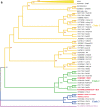Severe acute respiratory syndrome (SARS) related coronavirus in bats
- PMID: 34778877
- PMCID: PMC8062212
- DOI: 10.1186/s44149-021-00004-w
Severe acute respiratory syndrome (SARS) related coronavirus in bats
Abstract
Three major human coronavirus disease outbreaks, severe acute respiratory syndrome (SARS), Middle East respiratory syndrome (MERS) and 2019 coronavirus disease (COVID-19), occurred in the twenty-first century and were caused by different coronaviruses (CoVs). All these viruses are considered to have originated from bats and transmitted to humans through intermediate hosts. SARS-CoV-1 and SARS-CoV-2, disease agent of COVID-19, shared around 80% genomic similarity, and thus belong to SARS-related CoVs. As a natural reservoir of viruses, bats harbor numerous other SARS-related CoVs that could potentially infect humans around the world, causing SARS or COVID-19 like outbreaks in the future. In this review, we summarized the current knowledge of CoVs on geographical distribution, genetic diversity, cross-species transmission potential and possible pathogenesis in humans, aiming for a better understanding of bat SARS-related CoVs in the context of prevention and control.
Keywords: Bat; Cross-species; Geographical distribution; SARS-related coronavirus; Spillover.
© The Author(s) 2021.
Conflict of interest statement
Competing interestsThe author declares that he/she has no competing interests.
Figures




References
-
- Ahn, M., D.E. Anderson, Q. Zhang, C.W. Tan, B.L. Lim, K. Luko, M. Wen, W.N. Chia, S. Mani, L.C. Wang, J.H.J. Ng, R.M. Sobota, C.A. Dutertre, F. Ginhoux, Z.L. Shi, A.T. Irving, and L.F. Wang. 2019. Dampened NLRP3-mediated inflammation in bats and implications for a special viral reservoir host. Nature Microbiology 4 (5): 789–799. 10.1038/s41564-019-0371-3. - PMC - PubMed
-
- Becker, M.M., R.L. Graham, E.F. Donaldson, B. Rockx, A.C. Sims, T. Sheahan, R.J. Pickles, D. Corti, R.E. Johnston, R.S. Baric, and M.R. Denison. 2008. Synthetic recombinant bat SARS-like coronavirus is infectious in cultured cells and in mice. Proceedings of the National Academy of Sciences of the United States of America 105 (50): 19944–19949. 10.1073/pnas.0808116105. - PMC - PubMed
-
- Deshmukh, V., R. Motwani, A. Kumar, C. Kumari, and K. Raza. 2021. Histopathological observations in COVID-19: A systematic review. Journal of Clinical Pathology 74 (2): 76–83. 10.1136/jclinpath-2020-206995. - PubMed
Publication types
LinkOut - more resources
Full Text Sources
Research Materials
Miscellaneous
